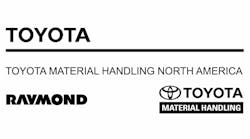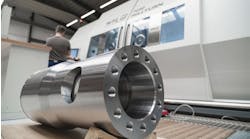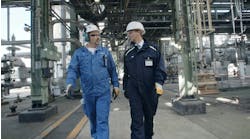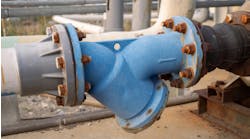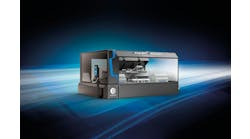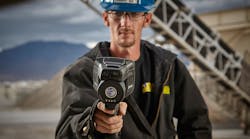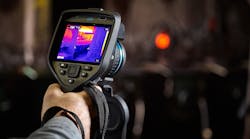Picture This: Thermal Imagers Bring Plant Safety and Maintenance into Focus
Imagine $4 million worth of assets going up in smoke. That's exactly what could have happened to one fruit processing facility described in a recent CNA report if thermal imaging scanners hadn’t detected critical electrical faults in its system.
Using thermal imaging cameras, the company was able to spot three serious issues and 10 more intermediate faults that, once corrected, saved the company thousands in electrical repairs and millions in potential damage.
This has become a standard story in the thermal imaging world. With over 60 years of development behind it, the technology plays a vital role in today's manufacturing world to keep plants safe and systems running smoothly and efficiently.
Recent technological advances at FLIR Systems have made thermal imagine even more valuable to these applications.
We recently spoke with two representatives from FLIR—the global leader in the design, manufacture, and marketing of thermal imaging infrared cameras—for a more in-depth look at how thermal imagers are reducing safety risks and improving preventive maintenance in manufacturing plants.
The company recently introduced its expanded Exx-Series and T-Series line of thermal imagers—incredibly advanced and redesigned systems that take thermal imaging to a new level.
We recently spoke with two representatives from FLIR for a more in-depth look at how thermal imagers are reducing safety risks and improving preventive maintenance in manufacturing plants. Brent Lammert, Vice President of Business Development for FLIR’s Volume Segment, and Craig O’Neill, Business Development Manager in the Americas for FLIR’s Premium Segment, gave us their insights.
NED: Why is temperature measurement so important in an industrial environment?
O’Neill: Temperature is often the No. 1 reason for equipment failure. In a manufacturing facility, there could be many reasons for temperature changes. It might simply be a friction or misalignment issue for mechanical applications, but even more common in most manufacturing facilities is failure of electrical components that causes a heat change within the equipment.
That’s where thermal imaging allows you to immediately diagnose the issue. And with these higher-end cameras, you can quantify the severity of the issue much more effectively by comparing the temperature change to an equivalent piece of equipment that is operating under normal conditions.
NED: How does thermal imaging compare to traditional temperature-measurement methods on the plant floor?
O’Neill: Historically, and even in industry today, there are many people who understand the need to measure temperature for preventive maintenance but may have an outdated methodology of temperature measurement. Thermal imagery, in particular FLIR’s Exx-Series and the new T500-Series, allows you to get an image—with temperature measurements across the entire scene—versus just a number. The historical temperature measurement for preventive maintenance is just a simple spot gun. That technology is inefficient because you have to be quite close to the equipment, and you only have a single temperature reading for that point. Whereas, FLIR’s E95 and T540 cameras record images that provide a little over 160,000 temperature measurement pixels.
For example, if you’re looking at a bearing that’s 20 or 30 feet away, you immediately get an accurate temperature—even if it’s a very small area because of the number of pixels within the image. With a spot gun or temperature measurement tool, you might only be able to take a 1-inch temperature measurement at 12 inches away. You would have a lot of trouble accurately measuring the temperature and, even more importantly, have difficulty seeing where a fault is located because you don’t have a true thermal image.
NED: Today, we hear a lot about the value of Big Data and plant-floor analytics. Can you integrate thermal imaging technology with enterprise systems?
O’Neill: One of the conveniences of the FLIR line of cameras is the simplicity of the image gathering. All images stored with a FLIR camera are basic JPEG images, so we have internal software that will allow you to take this single JPEG image and analyze it after the fact and even make reports in Microsoft Word with a radiometric JPEG image. Also, because the image that we store is not proprietary, you can embed that image in most third-party software that can simply take an attachment of a single image.
Lammert: We also have a software-developer kit that allows developers of CMMS-type programs to pull specific data out of the image or pull in the entire image and have that temperature data, the date and time, and even some of the text comments from the operator of the camera pulled into their overall data stream. There are several CMMS products on the market that have already integrated FLIR products into them, and that’s something that can be added to most other CMMS systems. Then, in addition to the handheld cameras we’ve been talking about, we also have a line of permanently mounted continuous-monitoring cameras that can feed directly into those systems on a continuous basis.
NED: What type of applications are ideal for a permanently mounted camera?
Lammert: It tends to be the critical infrastructure for that facility. For example, the main incoming power or a circuit breaker or motor control center panel that is essential for the operation of the plant. Many plants will then branch out into areas that are more difficult to reach or where there are some safety concerns.
NED: That leads into another important topic for manufacturers, which is safety. Can you discuss how that translates into safer operations?
O’Neill: That’s one of the great things about these cameras. One common thread I’ve seen at every manufacturing facility is a sign that says “We have gone X amount of days without an OSHA incident.” With thermal imaging cameras, you can stay a safe distance away and accurately diagnose the equipment. Electrical systems are often where the safety consideration is most important because there are OSHA standards that require the user to be a certain distance away from certain types of electrical equipment. An important new feature of the E75/E85/E95 models and the T500-Series is a laser-distance range finder: It allows you to push a button on the camera, which activates a red laser that tells you exactly how far away you are from the equipment you’re serving. That helps users ensure they’re meeting safety standards and maintaining an appropriate safe distance away from their energized electrical switchgear.
We have other levels of safety features that we can install in switchgear to monitor that 24/7. With the FLIR Ax8, any time the temperature crosses a defined threshold, it can send an alarm or an image to an iPhone to show you that you have a fault.
Learn more about FLIR's latest thermal imagers on the NED Directory.
